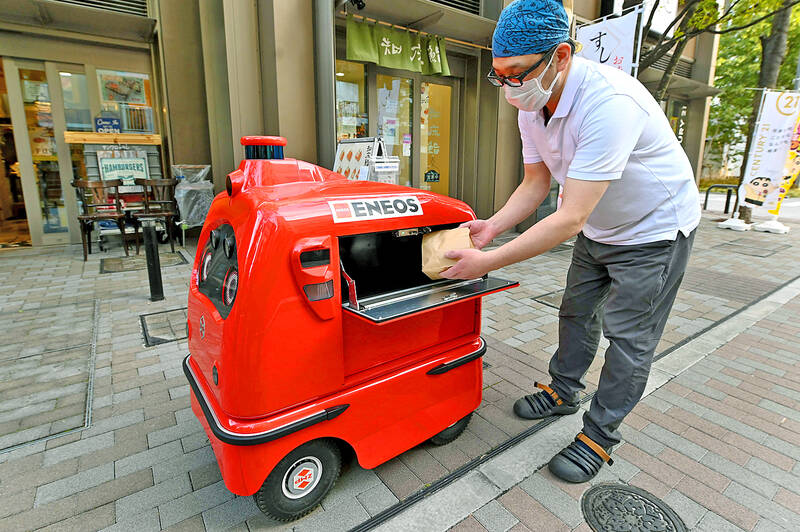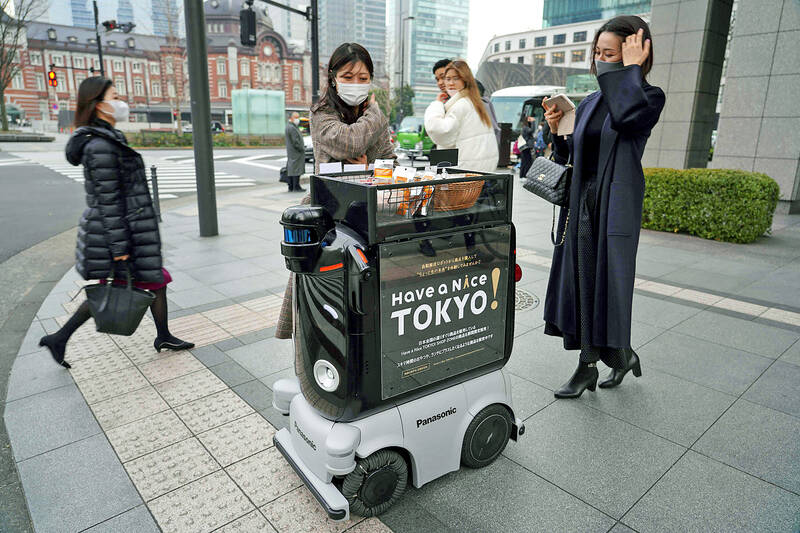“Excuse me, coming through,” a four-wheeled robot chirps as it dodges pedestrians on a street outside Tokyo, part of an experiment businesses hope will tackle labor shortages and rural isolation.
From April, revised traffic laws are to allow self-driving delivery robots to navigate streets across Japan.
Proponents hope the machines could eventually help elderly people in depopulated rural areas gain access to goods, while also addressing a shortage of delivery workers in a country with chronic labor shortages.

Photo: AFP
However, there are challenges to overcome, including safety concerns, said Hisashi Taniguchi, president of Tokyo-based robotics firm ZMP Inc.
“They are still newcomers in human society, so it is natural they’re seen with a bit of discomfort,” he said. “The robots would not be operating entirely alone, with humans monitoring remotely and able to intervene.”
It is important the robots “are humble and lovable” to inspire confidence, Taniguchi said.

Photo: AFP
ZMP has partnered with behemoths such as Japan Post Holdings Co in its trials of delivery robots in Tokyo.
Its “DeliRo” robot aims to look charming, and features big, expressive eyes that can be made teary if pedestrians block its way.
“Every kid around here knows its name,” he said.
There is a serious purpose behind the cuteness.
Japan has one of the world’s oldest populations, with nearly 30 percent of its citizens over the age of 65. Many live in depopulated rural areas that lack easy access to daily necessities.
Labor shortages in its cities and new rules limiting overtime for truck drivers also make it difficult for businesses to keep up with COVID-19 related e-commerce and delivery demands.
“The shortage of workers in transport will be a challenge in the future,” said Dai Fujikawa, and engineer at electronics giant Panasonic Corp, which is trialing delivery robots in Tokyo and nearby Fujisawa.
“I hope our robots will be used to take over where needed and help ease the labor crunch,” he said.
Regulations set a maximum speed of 6kph, meaning the “chances of severe injury in the event of a collision are relatively small,” said Yutaka Uchimura, a professor of robotic engineering at Shibaura Institute of Technology.
If a robot “moves off the sidewalk and collides with a car due to some discrepancy between the preinstalled location data and the actual environment, that would be extremely worrying,” he said.
Panasonic said its “Hakobo” robot can judge autonomously when to turn, as well as detect obstacles, such as construction and approaching bikes, and stop.
One person at the Fujisawa control center simultaneously monitors four robots via cameras and is automatically alerted whenever their robotic charges are stuck or stopped by obstacles, Fujikawa said.
Humans would intervene in such cases, as well as in high-risk areas such as junctions.
Hakobo is programmed to capture and send real-time images of traffic lights to operators and await instructions.
Test runs have so far ranged from delivering medicine and food to Fujisawa residents to peddling snacks in Tokyo with disarming patter such as: “Another cold day, isn’t it? How about some hot drinks?”
Authorities do not believe Japanese streets are soon to be teeming with robots, given the pressure to protect human employment.
“We don’t expect drastic change right away, because there are jobs at stake,” said Hiroki Kanda, an official from the Japanese Ministry of Economy, Trade and Industry, which is promoting the technology.
“The spread of robots will be more of a gradual process, I think,” Kanda said.
Uchimura is aware of the technology’s limitations, and believes rolling the robots out in sparsely populated rural areas first would be safest.
However, firms say that demand in cities is likely to make urban deployment more commercially viable.
Taniguchi hopes to eventually see the machines operating everywhere.
“I think it would make people happy if, with better communication technology, these delivery robots can patrol a neighborhood or check on the safety of elderly people,” he said. “Japan loves robots.”

WEAKER ACTIVITY: The sharpest deterioration was seen in the electronics and optical components sector, with the production index falling 13.2 points to 44.5 Taiwan’s manufacturing sector last month contracted for a second consecutive month, with the purchasing managers’ index (PMI) slipping to 48, reflecting ongoing caution over trade uncertainties, the Chung-Hua Institution for Economic Research (CIER, 中華經濟研究院) said yesterday. The decline reflects growing caution among companies amid uncertainty surrounding US tariffs, semiconductor duties and automotive import levies, and it is also likely linked to fading front-loading activity, CIER president Lien Hsien-ming (連賢明) said. “Some clients have started shifting orders to Southeast Asian countries where tariff regimes are already clear,” Lien told a news conference. Firms across the supply chain are also lowering stock levels to mitigate

IN THE AIR: While most companies said they were committed to North American operations, some added that production and costs would depend on the outcome of a US trade probe Leading local contract electronics makers Wistron Corp (緯創), Quanta Computer Inc (廣達), Inventec Corp (英業達) and Compal Electronics Inc (仁寶) are to maintain their North American expansion plans, despite Washington’s 20 percent tariff on Taiwanese goods. Wistron said it has long maintained a presence in the US, while distributing production across Taiwan, North America, Southeast Asia and Europe. The company is in talks with customers to align capacity with their site preferences, a company official told the Taipei Times by telephone on Friday. The company is still in talks with clients over who would bear the tariff costs, with the outcome pending further

Six Taiwanese companies, including contract chipmaker Taiwan Semiconductor Manufacturing Co (TSMC, 台積電), made the 2025 Fortune Global 500 list of the world’s largest firms by revenue. In a report published by New York-based Fortune magazine on Tuesday, Hon Hai Precision Industry Co (鴻海精密), also known as Foxconn Technology Group (富士康科技集團), ranked highest among Taiwanese firms, placing 28th with revenue of US$213.69 billion. Up 60 spots from last year, TSMC rose to No. 126 with US$90.16 billion in revenue, followed by Quanta Computer Inc (廣達) at 348th, Pegatron Corp (和碩) at 461st, CPC Corp, Taiwan (台灣中油) at 494th and Wistron Corp (緯創) at

NEGOTIATIONS: Semiconductors play an outsized role in Taiwan’s industrial and economic development and are a major driver of the Taiwan-US trade imbalance With US President Donald Trump threatening to impose tariffs on semiconductors, Taiwan is expected to face a significant challenge, as information and communications technology (ICT) products account for more than 70 percent of its exports to the US, Chung-Hua Institution for Economic Research (CIER, 中華經濟研究院) president Lien Hsien-ming (連賢明) said on Friday. Compared with other countries, semiconductors play a disproportionately large role in Taiwan’s industrial and economic development, Lien said. As the sixth-largest contributor to the US trade deficit, Taiwan recorded a US$73.9 billion trade surplus with the US last year — up from US$47.8 billion in 2023 — driven by strong